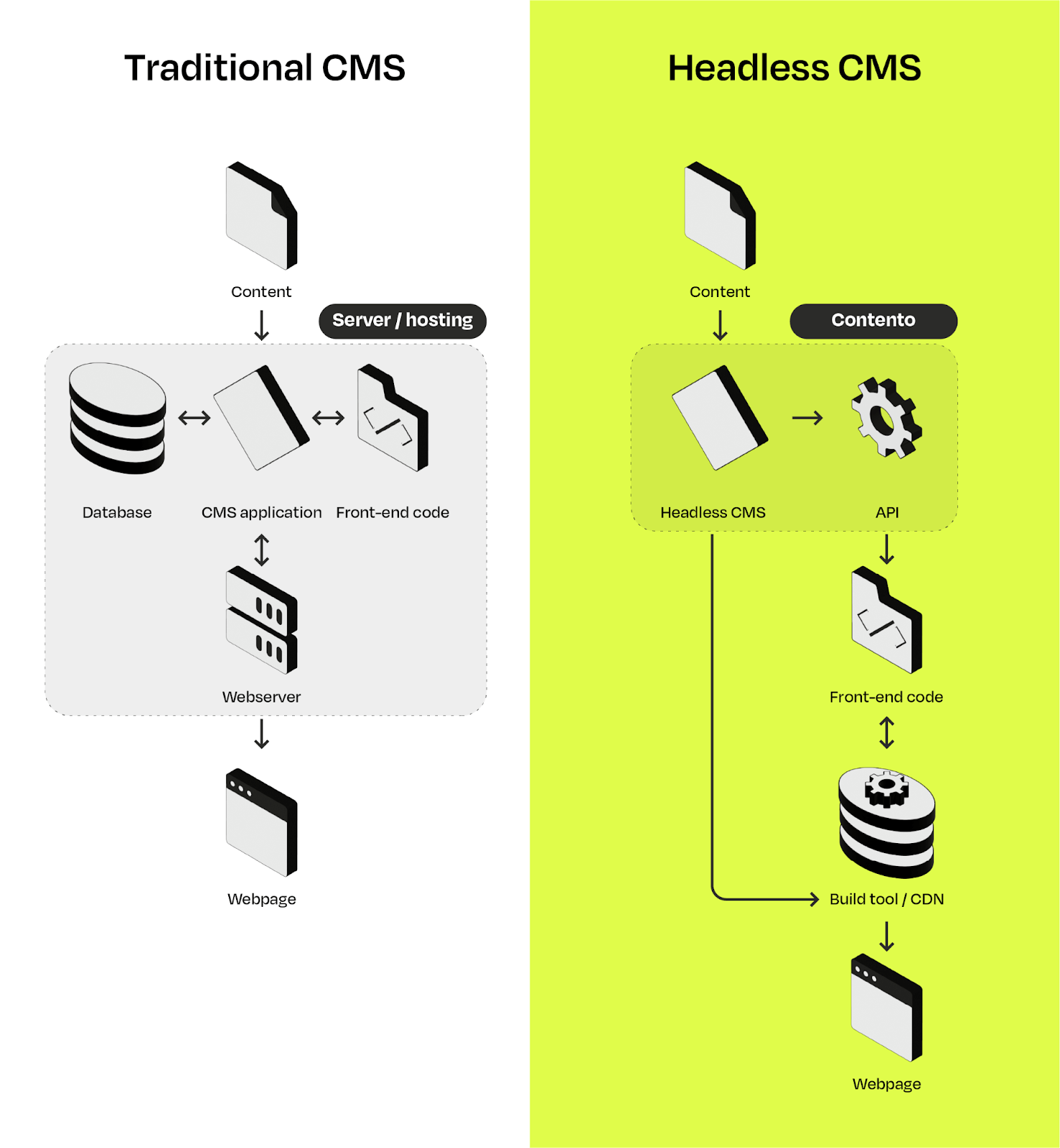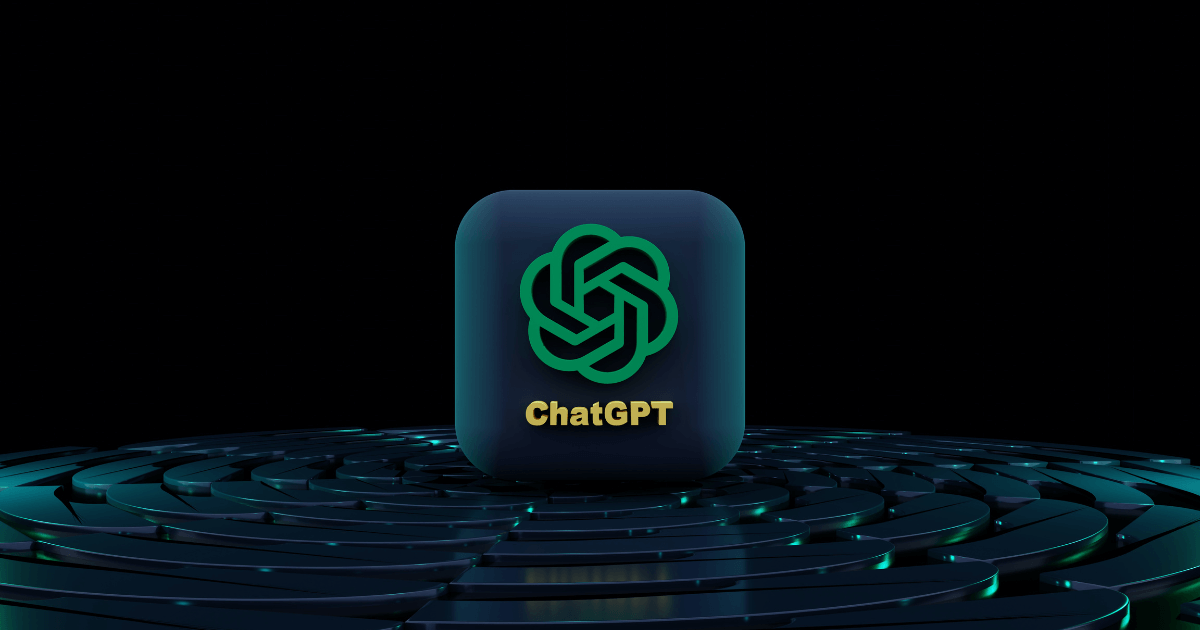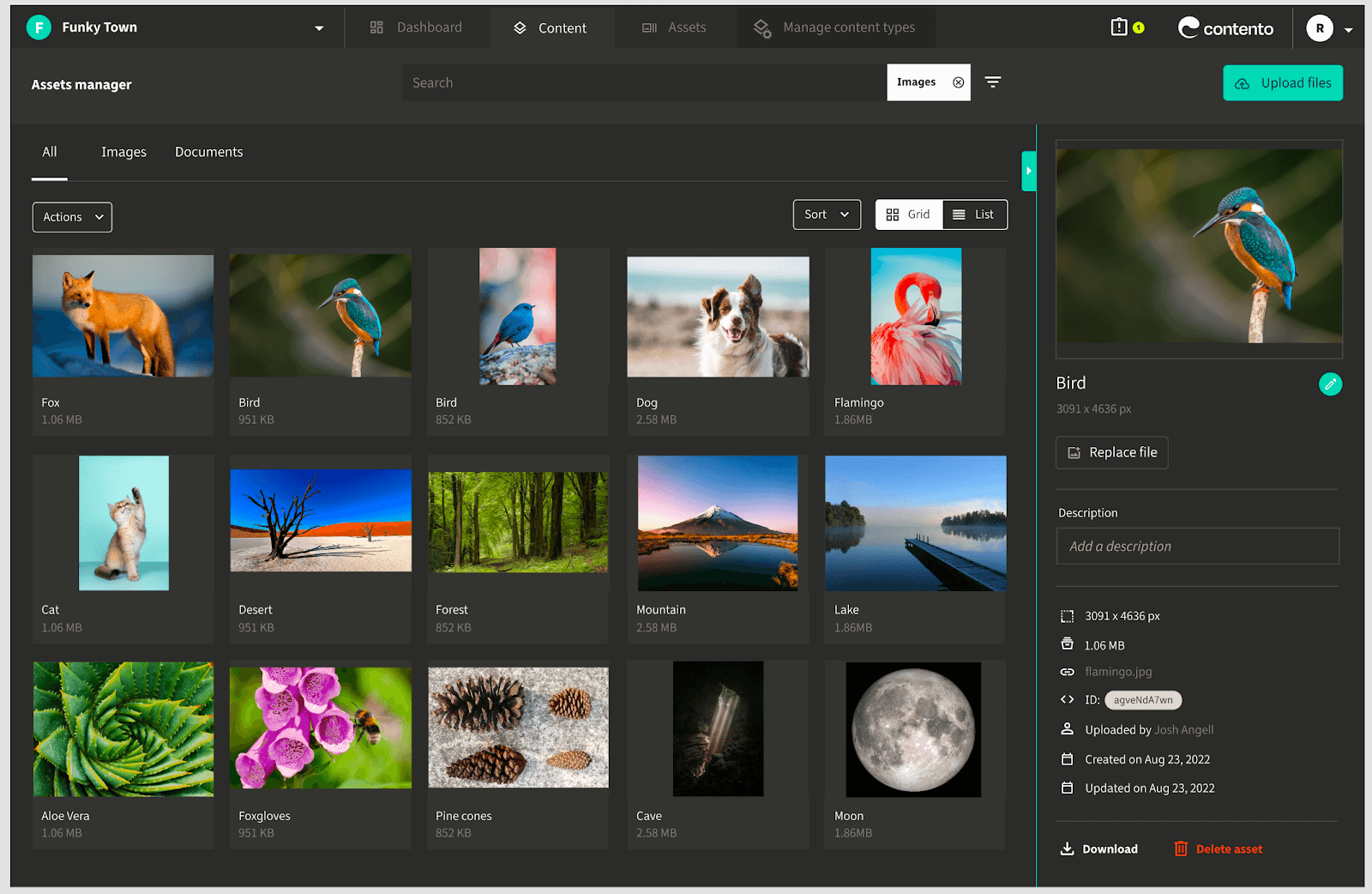This article aims to (a) describe what is a Headless CMS, and (b) outline what you as a Marketer need to know about it.
The strangely named category of CMS called ‘Headless’ refers to a Headless Content Management System (CMS) or Headless CMS, in contrast to a traditional monolithic CMS like WordPress. With a Headless CMS the front-end and back-end are separated (or decoupled) and the back end acts as a content repository that feeds ‘the head’ be that a website, APP, or device.

Traditional CMS (Monolithic) like WordPress
This new emergent category of Headless has been gaining a lot of attention, particularly in the developer community. However, adoption has now grown significantly in recent years such that major brands like Notion, Costa Coffee, Specsavers, Nike, MailChimp, Vodafone, Spotify, Twilio, Atlassian, Bang & Olufsen, McDonald’s, Google, deliveroo, GoCardless, Sonos, Adidas, and Pizza Hut, all utilize a Headless CMS to power some if not all of their websites.
So what accounts for its growing popularity?
First, we need to go back in time.
WordPress is by far the most popular traditional CMS globally. It is probably one of the few CMSs that people outside of marketing/tech teams will have heard of. However, it’s now 20 years old, was built at a very different age (compared to where we are now in terms of Internet maturity), and was also designed primarily to power a blog.
Fast-forward 20 years and it is simply no longer fit for purpose for fast-growing websites. This last bit is of course crucial. Choosing a CMS is very context-dependent. The optimal choice of CMS will relate to several factors including whether usage is business or personal, whether a basic brochure wear site or content-heavy marketing website, and so on.
The focus of this article is very much on growing commercial websites (consumer and business), especially, from the broader B2B, SaaS, and technology landscape. For these commercial categories, it is increasingly difficult to justify WordPress as a ‘good choice’ when selecting a CMS.
However, like every category with commercial interests, there is also a significant WordPress ecosystem that will likely challenge these below assumptions, especially given I am advocating for ‘my category’ - the Headless CMS one over Traditional ones. As I will argue below though, it’s more than just a ‘shiny new toy’.
Finally, in terms of what a Traditional CMS is: the goal of a traditional CMS is to provide an easy-to-use platform for content creation and management, while also allowing for flexibility and customization through the use of templates, themes, and plugins. With a traditional CMS, the front end and back end are closely coupled and the front end often relies on themes and templates to display content. However, while this all-in-one solution can be convenient, it also brings several challenges, especially for those tasked with delivering better conversion rates.

Common issues with traditional CMSs like Wordpress
So what are some of the issues with WordPress to be aware of?
Security vulnerabilities
Plugins and Themes represent the core components of most WordPress websites. However, these need to be actively managed and maintained, something that’s not always done in a timely manner. This is especially the case when no dedicated external WordPress developer retainer is in situ and you are relying on in-house junior marketers to manage the site. This very context combines to introduce security vulnerabilities that are concerning.
Usability challenges
The reality for most marketing teams is that someone relatively junior and often non-technical will be responsible for managing the content in WordPress. The UI/ UX can be very confusing (even for developers) for a mature WordPress site with legacy plugins in situ and after numerous actors have been “involved” with the site since it went live years before.
Mediocre performance
When it comes to performance, mature WordPress sites often struggle. This can be due to website bloat, poor image compression, or the use of an excessive amount of plugins, amongst other factors. It is probably not the ideal system to bank on to deliver a page load time of under 1 second (ignoring throwing a lot of money at the problem) or to deliver improved conversion rates given the negative correlation between page speed and conversions.
Broad use cases
While WordPress is fundamentally a free open-source CMS, and is used by millions of people around the world, its dominant user base is personal websites. By having such a wide community of users, it has to rely on Plugins to bring features specific to the different use cases e.g commercial use.
Other issues to be aware of include:
- There are numerous hidden costs associated with WordPress - you’ll likely need a WordPress developer on retainer just in case you encounter problems
- Even experienced WordPress developers acknowledge that updating plugins carries significant risks, such as website crashes that require time-consuming recovery efforts.
- WordPress and its UI were built with single author access in mind which runs counter to the modern reality of marketing team collaboration.
Other Traditional CMSs
When it comes to other traditional CMSs other than WordPress we find some of the same issues crop up (but they tend to differ from CMS to CMS). It is also worth noting that in many instances it is not the CMS per se that is the “main issue” negatively impacting performance- it is often how it was “typically built out over several years” that exacerbates the problems or as Dries Buytaert, the founder of Drupal argues:
“....the performance of a website depends more on the HTML, CSS, JavaScript code and assets (images, video, fonts) than the underlying technology used.”
In short, traditional CMSs, of which WordPress is by far the most popular, have several drawbacks when it comes to those looking to power modern websites in 2023. Some relate to the CMS choice, others relate to the build, while others relate to on-page elements like using uncompressed images, etc.

How does a Headless CMS work?
A Headless CMS is a content platform or content management system that delivers content through APIs without any predefined templates or presentation layers. It is called "Headless" because it doesn't have a user-facing front-end, or "Head".
Here's how a Headless CMS typically works:
1. Content creation: Users create content in the CMS (logging in via their browser)
2. Content storage: The CMS stores the content acting as a content repository/database.
3. API Access: The CMS provides API access to the content, allowing developers to retrieve and manipulate the content programmatically.
4. Front-end integration: The front-end (usually the website or mobile app), retrieves content from the CMS via its API, and then renders the content using its own templates and presentation layer.
Because the front-end system is decoupled from the CMS, developers have more control over the presentation layer and can use any technology they want to create the user interface. This also makes it easier to reuse content across multiple channels and devices, as the CMS provides a central repository of content that can be accessed by any front-end system.

What does a Headless CMS offer?
So what are some of the main advantages of opting for a Headless CMS?
Again, I’ll look at them through the lens of using a Headless CMS to primarily power a B2B, SaaS, or technology website.
Design freedom
With a Headless CMS, you are not wedded to a template (although you will be very much relying on components/ blocks) so your front-end developer has free reign as to the design. They don’t need to worry about the content, as that will be managed from the content platform i.e. the Headless CMS.
Lightning quick performance
Headless CMS-architected websites can be highly performant which helps optimize both your conversion rates and your SEO efforts. Given they are based on the use of Static Site Generators (SSGs) and Content Delivery Networks (CDNs) which are geographically dispersed, performance rates can be hard to match when compared to the performance of traditional CMSs.
Enhanced security
A Headless CMS is not more or less inherently secure than a traditional CMS, as it ultimately depends on how the CMS is designed and implemented. However, some elements make it more secure in certain circumstances.
A Headless CMS typically has a smaller attack surface compared to a traditional CMS because it does not include the front-end website or application. This means that there are fewer points of entry for potential attackers to exploit. Similarly, vulnerabilities in one area (e.g. the delivery layer) do not necessarily affect the security of the CMS itself.
Endlessly scalable
Headless CMSs are designed to be scalable, which means they can handle large amounts of content and traffic without sacrificing performance. Decoupling content storage and content delivery means that as the amount of content grows, the CMS can handle it without slowing down the delivery of content to the end users. Add in the distributed architecture (use of Content Delivery Networks), caching and the API-powered architecture and it means sites can scale without sacrificing performance.

What drawbacks are associated with a Headless CMS?
There are also several disadvantages with Headless to be aware of.
Need for technical expertise
You will need access to a front-end developer familiar with the Jamstack architecture to help build the website initially (and for the odd bit of maintenance). However, when it comes to the skillset most B2B, SaaS, or tech companies will likely have the requisite skills in-house if needed.
Need to manage multiple platforms and tools.
Given the API-based nature of Headless, married to the decoupled nature several different elements need to be integrated. Again from experience, these are all pretty standard and something most developers will be comfortable with.
The potential for complexity
A Headless CMS-based site could get complex as it grows e.g. As the amount of content grows, it can become more challenging to create a robust content model that accommodates all the different types of content that need to be managed. Similarly, there may be lots of integrations needed.
Summary
Twenty years after its introduction WordPress is no longer a viable choice for those seeking highly performant websites. The category of Headless CMS has emerged in recent years as a credible alternative to traditional CMSs and offers some powerful benefits meaning you can enjoy a beautifully designed and highly performant website that is easy to manage and maintain when compared to traditional CMSs.
As someone working in marketing, your website represents a key window on the world, and a Headless CMS-backed site offers you the ability to create a beautifully designed, highly performant website that does not suffer from some of the issues impacting Traditional CMSs like WordPress.
Need advice on choosing the right CMS? Have you got some hot tips on what works best for your organization? Join the conversation with a global network of CMOs and marketing leaders on the CMO Alliance Community Slack channel.




 Follow us on LinkedIn
Follow us on LinkedIn




